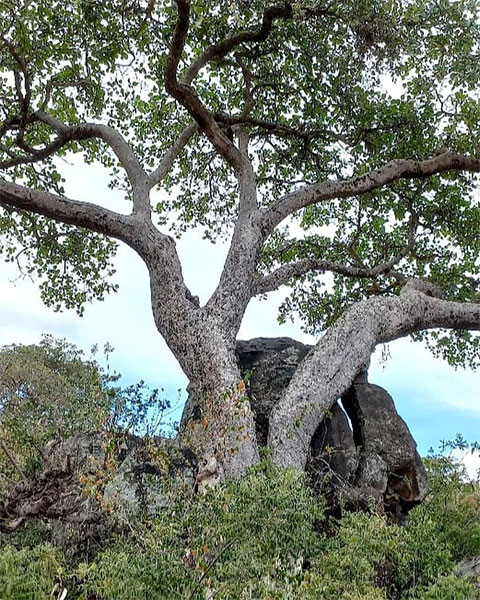These fruit trees can turn CO₂ into rock
Scientists have recently discovered that certain plants can create limestone-like deposits in their trunks and surrounding soil, locking up carbon in an extremely stable form. This little-known carbon-transfer pathway, previously studied mainly in non-fruit-bearing trees, could become a powerful natural tool in the fight against climate change, especially if scaled up through agroforestry systems.
New research led by a team of scientists from Kenya, the US, Austria and Switzerland reveals that a species of fig in Kenya possesses an incredible ability: it can absorb carbon dioxide (CO₂) from the air and sequester it by creating calcium carbonate – essentially creating rock inside the tree trunk and in the surrounding soil.
These trees are among the first known fruit-bearing plants to use a process called the 'oxalate-carbonate pathway.' That means they not only store carbon the way most plants on Earth do—by growing wood and leaves—but also lock it away in solid minerals, deep inside their trunks and in the surrounding soil.
Normally, plants use photosynthesis to take CO₂ from the air and turn it into organic matter like wood, leaves and roots. That's why reforestation is often seen as a natural climate solution.
But some plants can use CO₂ to create tiny crystals called calcium oxalate. As plant parts die and decompose, bacteria and fungi convert these crystals into calcium carbonate. This mineral not only stores carbon much longer than organic matter, but also makes the soil around the plant more alkaline and rich in nutrients.
Dr Mike Rowley, senior lecturer at the University of Zurich (UZH), said: ' We have known about the oxalate-carbonate pathway for a long time, but its carbon sequestration potential has not been fully considered. If we are growing trees for agroforestry systems with the ability to store CO₂ as organic carbon and produce food, it may be possible to select trees that provide the additional benefit of sequestering inorganic carbon as well, in the form of calcium carbonate. '
The team looked at three species of figs grown in Samburu County, Kenya. They measured the distance from the trunk where calcium carbonate was forming and identified the microbial communities involved in the process. Using synchrotron analysis (using a powerful beam of X-rays), the team found that calcium carbonate was forming both on the outer surface of the trunk and deeper inside the wood.

Dr Rowley explains: ' As calcium carbonate forms, the soil around the tree becomes more alkaline. Calcium carbonate forms both on the surface of the tree and within the wood structure, presumably as microorganisms break down the crystals on the surface and also penetrate deeper into the tree. It suggests that inorganic carbon is being sequestered deeper within the wood than we previously realised. '
Of the three fig species studied, the scientists found that Ficus wakefieldii (a species of the fig genus) was the most efficient at sequestering CO₂ into calcium carbonate. The scientists now plan to assess the tree's suitability for agroforestry systems by quantifying its water needs and fruit yields, and to analyse in more detail how much CO₂ can be sequestered under different conditions.
Most research on the oxalate-carbonate pathway has been conducted in tropical environments and has focused on non-food-producing trees. The first plant identified to exhibit active oxalate-carbonate synthase behaviour was the Iroko tree (Milicia excelsa, also known as African teak), which can sequester a tonne of calcium carbonate in the soil over its lifetime.
Calcium oxalate is one of the most abundant biominerals, and many plants produce these crystals. Microorganisms that convert calcium oxalate to calcium carbonate are also common.
 Animals That Could Reshape Earth's Waterways
Animals That Could Reshape Earth's Waterways New research shows fish are smarter than we thought
New research shows fish are smarter than we thought How dangerous is the toxic substance in the poison ivy that can kill people in a short time?
How dangerous is the toxic substance in the poison ivy that can kill people in a short time? What is the Strait of Hormuz and why is it important?
What is the Strait of Hormuz and why is it important? What is a krait? Why do kraits often crawl into houses?
What is a krait? Why do kraits often crawl into houses? Interesting facts about the great white shark
Interesting facts about the great white shark